page 1
(Using a philosophy of "threes" as a tool
for dissection and comparative analysis)
~ The Study of Threes ~
http://threesology.org
Anat., Bio. Phys. Researchers as of 3/17/2021
Pages in this series:
| 1 | 2 | 3 | 4 | 5 | 6 | 7 | 8 | 9 | 10 | 11 |
Note: If you have come looking for patterns-of-three in Anatomy, please go to this site: List of Threes in Human Anatomy By Dr. McNulty and associates. My method of categorizing may not suit the taste of those want either an encyclopedic, dictionary or library model of listing different items. My method is one in which a Journalistic "jotting down" profile of examples is being kept as I pursue different avenues of research.
In reflection, with respect to the title of this page, it is necessary to point out that my usage of the words "anatomy" and "physiology" can be broadly applied to include inanimate objects and occurrences as well as subject areas in which such words are not typically applied. For example, one can speak of the anatomy and physiology of an chemical, electric or mechanical motor just as one might describe a society as a functional biological entity. No less, the word "scaffolding" can be alternatively applied to biological, sociological or atomic processes though it most typically accompanies discussions involving building construction. Hence, if your mind does not permit you to explore too far beyond a given subject area, using words, symbols and drawings with which to architecturally draft ideas by simply using correlations and inferences, you might find some of the information here of little value if your thoughts are too securely tailored to conventionalities of consideration. For those of you who don't mind walking into fields of alternative mental and visual landscapes, make sure your intellectual compasses permit you to align the directional needle and orientational symbols as need be... without losing sight of the fact that compasses used on Earth are based on its peculiar environmental dispositions. In other words, conceptions of "true" north on Earth are not necessarily of applicable value on all planets, much less space or other dimensional sojourns.
I am going to venture into many different subject areas with the intent of stressing points about recurrences and limitations, as well as the presence of other patterns as part of, alongside of, or instead of a pattern-of-three. Sometimes I will show such a pattern where none now exists, though the information is available for anyone to compile. For example, someone may say that we have two eyes, and fail to mention that there is the available idea of having a third... mind's eye or a third ear (such as some musicians may claim) or a third hand (where one's mouth is used), and so on. Realistically, we don't have a third eye like the dominant two, but we may well have a misunderstanding about biology in that we are programmed for three but environmental pressures force the third one into a type of unpronounced tertiary development. However, one can provide a discussion in support of two eyes as well. Nonetheless, we can recognize patterns that both do and don't regularly occur, as well as the fact that there is a limitation to the overall patterns we do use over and over and over again.
While it is easy to discount the idea of a "threes" phenomena by claiming any number (or symbol, etc.) can be found to have multiple references if one sets out to deliberately find them, we must identify that not all numbers, symbols, etc., are found everywhere. Though there are many, there exists a limitation. And yes, we can claim that a representative example exists in a given instance, while another does not see it. In other words, a person can make up the existence because they honestly want to believe they see an example thereof. In other words, we can impose our belief onto a given instance in one moment, and yet at some time removed, we may wonder how we could possibly seen something that is not so obvious upon a later examination. Yes, we can fool ourselves and be fooled by others because of a given state of susceptibility. We are not infallible nor impervious to making errors... despite trying to mollify the mistake by saying we were using a type of creative license.
This is why many seek truth in areas of research which appear to offer definitive proof because their view can not only be verified by others, but there is a sustained presence of the truth which may alternatively be described as a natural law. Yet, not all sustained recurrences are called a natural law. Take for existence the repetitive nature of the pattern-of-three or its geometric counterparts in biology, physiology and anatomy. The occurrence of a repetitive "three" formula in human teeth for example, may not be described as a "anatomical law" because it does not occur in all life forms. Though the recurrence may occur in all humans, the lack of occurrence in a single mammal species may be used by some to say that the "law" is not universal... even though its presence is a common recurrence. Recurrences which take place under given conditions and not all conditions may be used by some as an argument against suggesting any relative importance, despite its recognition by millions of people.
Whereas many may well believe that the recurring "threes" in many subject areas is a curiosity and used by them to partake in an advantage to improve their desires, they may quickly dispense with its value if it is suggested that the recurrence is part of a larger perspective which argues against their particular application of the threes phenomena. For example, a person may have a philosophy which incorporates the idea of the Christian Trinity and that the presence of so many "threes" represents (to them) that their religious ideology is correct, but not like it if the same information is used to discount their belief as being little more than yet another "threes" example being individually applied as part of a survival mechanism of rationalization.
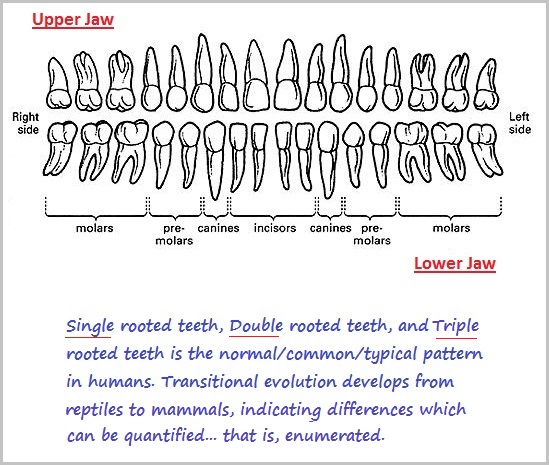
|
Typical(?) non-typical root variations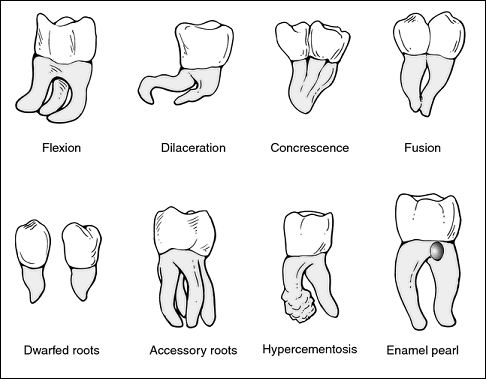 The Free Dictionary by Farlex |
| Note: I am not familiar with anyone who has done an extensive study on the non-typical variations, in order to determine frequency of occurrence, population differences (if any), which types are more frequent, etc., or how many dentists simply throw the anomalies away because they dismiss such occurrences as an anatomical/evolutionary irrelevance— instead of keeping a record of them, with images or the actual tooth. | |
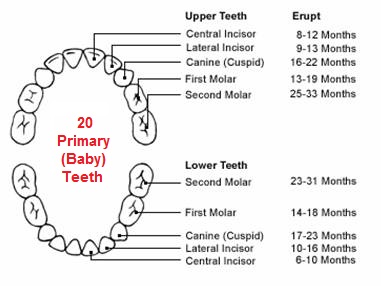 Source: Human Teeth Charts |
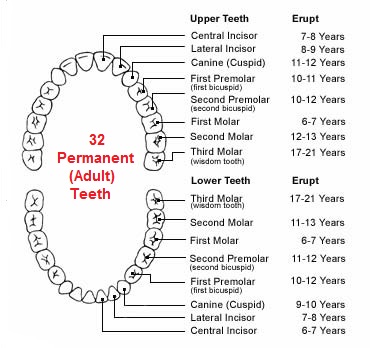 |
Yet, since humans are relatively recent on the scene of evolution, it is necessary to take into consideration developmental beginnings from which we can identify transitional formulas of anatomical change which, when applied with numbers, provide distinctions involving 1, 2, 3 and even additional models which may include 4, 5... etc., as well as fusion. I say "4, 5, etc.," so as to incorporate other anatomical features such as overall limb/finger/rib quantities as a means of indicating there exist limitations due to environmental circumstances/pressures, which no doubt has an affect on limiting human cognition such as intelligence and imagination. The following example of information involving transitional patterns of development speaks well for using enumeration as an analytical tool.
Source for the following table and introductory comments: Transitional Vertebrate Fossils FAQ Part 1B by Kathleen Hunt
This list starts with pelycosaurs (early synapsid reptiles) and continues with therapsids and cynodonts up to the first unarguable "mammal". Most of the changes in this transition involved elaborate repackaging of an expanded brain and special sense organs, remodeling of the jaws & teeth for more efficient eating, and changes in the limbs & vertebrae related to active, legs-under-the-body locomotion. Here are some differences to keep an eye on:
| # | Early Reptiles | Mammals |
| 1 | No fenestrae in skull | Massive fenestra exposes all of braincase |
| 2 | Braincase attached loosely | Braincase attached firmly to skull |
| 3 | No secondary palate | Complete bony secondary palate |
| 4 | Undifferentiated dentition | Incisors, canines, premolars, molars |
| 5 | Cheek teeth uncrowned points | Cheek teeth (PM & M) crowned & cusped |
| 6 | Teeth replaced continuously | Teeth replaced once at most |
| 7 | Teeth with single root | Molars double-rooted |
| 8 | Jaw joint quadrate-articular | Jaw joint dentary-squamosal (*) |
| (*) The presence of a dentary-squamosal jaw joint has been arbitrarily selected as the defining trait of a mammal. | ||
| 9 | Lower jaw of several bones | Lower jaw of dentary bone only |
| 10 | Single ear bone (stapes) | Three ear bones (stapes, incus, malleus) |
| 11 | Joined external nares | Separate external nares |
| 12 | Single occipital condyle | Double occipital condyle |
| 13 | Long cervical ribs | Cervical ribs tiny, fused to vertebrae |
| 14 | Lumbar region with ribs | Lumbar region rib-free |
| 15 | No diaphragm | Diaphragm |
| 16 | Limbs sprawled out from body | Limbs under body |
| 17 | Scapula simple | Scapula with big spine for muscles |
| 18 | Pelvic bones unfused | Pelvis fused |
| 19 | Two sacral (hip) vertebrae | Three or more sacral vertebrae |
| 20 | Toe bone #'s 2-3-4-5-4 | Toe bones 2-3-3-3-3 |
| 21 | Body temperature variable | Body temperature constant |
Some readers will be quick to notice differences in enumeration such as from single to double or single to triple, though fusion can take place as well. The first image below shows the dental formula of different mammals while the second one shows one jaw composition of an adult human's teeth.
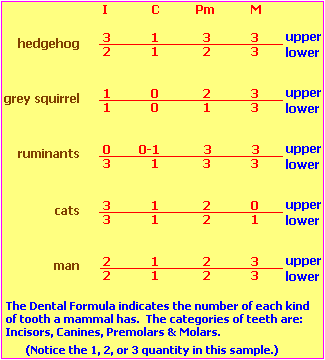 Threes Poster column 1 |
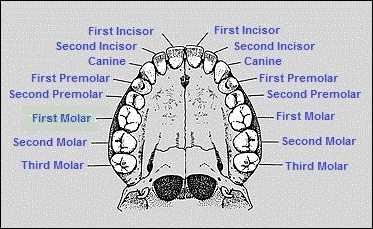 Dental Attrition |
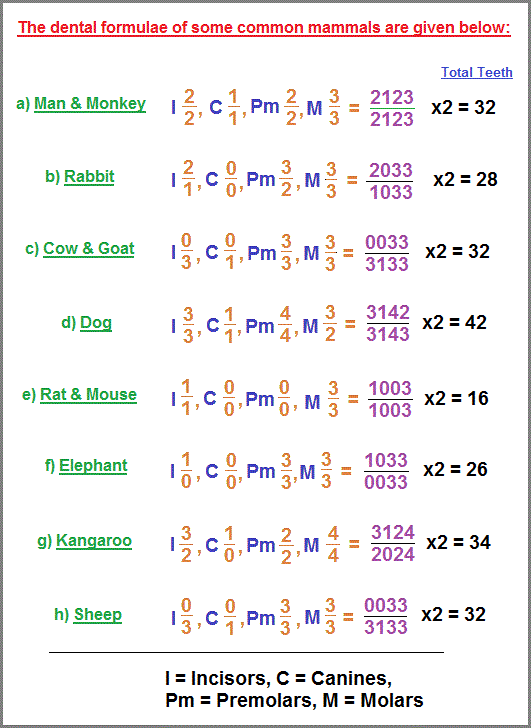 Image adapted from: BioZoom: Dental Formula |
|
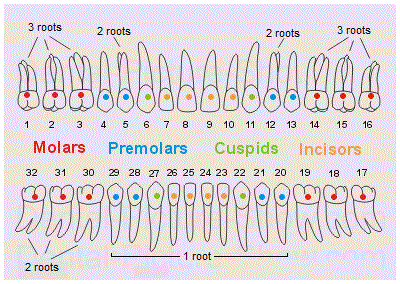 Dental Picture show.com |
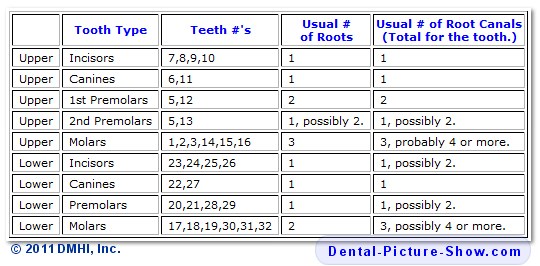 |
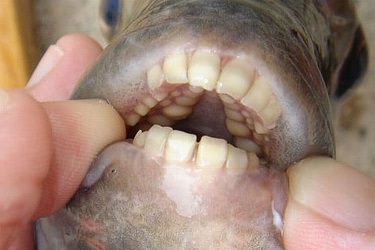 Human teeth in a Pacu fish or Fish teeth in humans? |
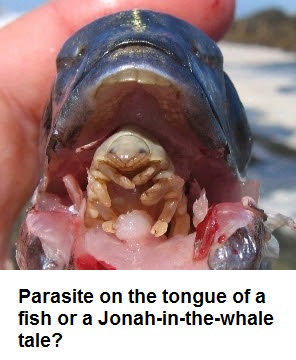 |
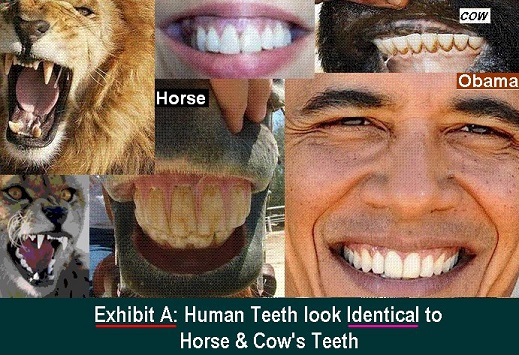 Humans Are Herbivores |
 Photos of Camels |
Yet, the enumerated patterns which we can apply to dentition (teeth), is a small bit of the larger occurrence of the "threes" phenomena to be found in anatomy and physiology. It's not that other patterns don't exist, it's just that the enumeration is not being looked upon with respect to an indication of a deteriorating environment that requires incremental adjustments be made as a coping... or adaptation... that can be identified as rationalization with respect to ideological changes.
The notion of "fusion" can be linked to the Sun's three "moments" called dawn, noon, and dusk. The rationale goes like this: Without the Sun, biology as we know it would be impossible, even those creatures which are in dark caves. Because of the dependency which biology has on the Sun, this "addiction" has forced anatomy and physiology to maintain a type of umbilical cord... sort of... attachment in that it mimics changes taking place in the physiology/anatomy of the Sun-Earth-Moon triad/complex. In addition, as the Earth's rotation slows and the Sun expands... even though we may not be able to identify the incremental changes... or define them as anomalies, the Sun's three "moments" will fuse together— and physiology/anatomy will have to take on this behavior as an adaptive characteristic. And let us not forget that an increasing human population causes related expansions in behavior as well as causing some things to slow down... while others may initially speed up like a set of billiard balls interacting with multiple other balls. No less, we must also contend with increased activity due to certain levels of increasing environmental temperatures, that at a given point can cause a decrease in behavior. I am speaking in generalities because not all of the variables are as yet placed into a single equation.
Like many things in the discussion of various events described as Evolution, the occurrences of "fusion" have not been forcibly articulated as a representative model of change for which a one-to-one correspondence of influence has been attempted with respect to any specific environmental event(s) or experience(s). For example, in the distant past there must have been something which occasioned the rise of a given quantity of toes/fingers, and yet this same increase provides an evolutionary record of a decrease. From nothing to a given number and then on some occasions, there is a decrease which may take on the expression of a fusion. Is it related to an overall incremental decay of the planet and/or planetary system?
Let me try to simply the above notion: If you look at the Sun at dawn, noon and dusk at the same time under present conditions (through a filtered lens of course), the Sun is seen as three "dots" in the sky. The more you slow down the Earth's spinning and increase the size of the Sun, the size of the three dots will increase to a point in which they overlap. This overlap is fusion. Any biological activity that is tied to it, whether or not we of the present can clearly identify such connections, will likewise fuse accordingly. Sometimes biological activity appears to be ahead of its time (in developmental maturation) and at other times it appears to be dragging its heels, just like some people whose ideas are said to be ahead of their time and others have views which appear to be more suited for a past age. While it is much easier for many of us to distinguish someone who appears to be "advanced" in their thinking, and in some cases we identify someone who is suggested as being "advanced" in physiology, we do not know the full spectrum of what "advancement" (or backwardness) means when the full spectrum of our biology/anatomy/physiology are taken into account. We are still very naive in this day and age.
Now let's move on to audiology (hearing):
Because hearing is related to speech and some consider speech asserts a tit-for-tat influence on brain development and cognition, we can not speak of one without giving a reference to the other, though many attempt to hold them as different hostages of research. The importance of hearing... on speech, is easily recognized when one observes a deaf person attempting to vocalize. No doubt there are variations of compensatory behavior that come into play to perform some substitute functioning like an adaptive brain which may develop a "speech center" in the right brain hemisphere if there is some type of obstructive occurrence which prevents the "speech center" from developing in its typical left hemisphere abode, this occurrence is noted in passing so that those readers who are accustomed to criticizing another's research in an area they feel they have acquired some expert knowledge about a given subject, don't attempt to interject the idea as a means of discounting the general statements and information being provided.
|
| |
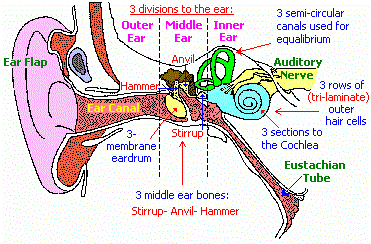 |
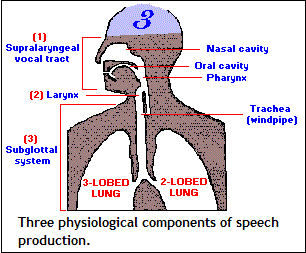 |
| 3 overall divisions: | Outer ear~ Inner ear~ Middle ear |
| 3 middle ear divisions: | Tympanum~ Epitympanum~ Mastoid antrum |
| 3 eardrum membranes: | Cutaneum~ Collagen fibers~ Mucosm |
| 3 semi-circular canals: | Used for balance (equilibrium) |
| 3 bones: | (ossicular chain) Incus~ Stapes~ Malleus |
| 3 main malleus ligaments: | Anterior~ Lateral~ Superior |
| 3 incus anchorage points: | Malleus~ Stapes~ Bony fossa wall |
| 3 cochlea sections: | (Scala) Vestibuli~ Tympani~ Cochlear duct |
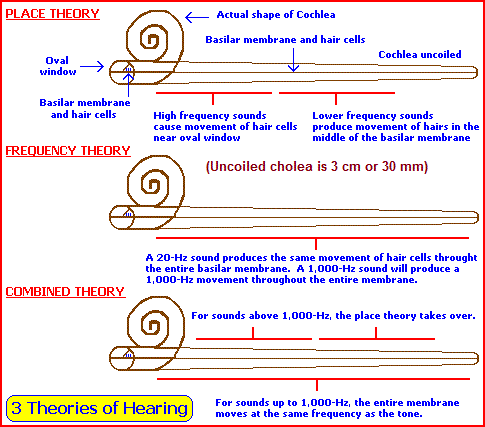 Language 3s page 1 |
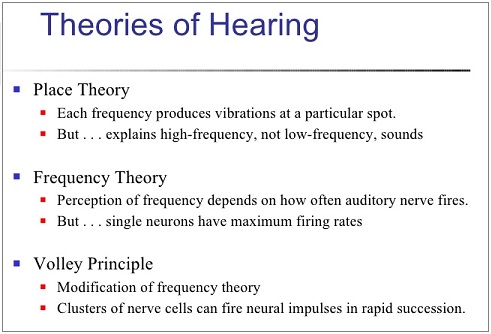 Various images on hearing |
| 3 extrinsic muscles (Auricularis): | Anterior~ Superior~ Posterior |
| 3 sound conduction paths: | Electrical~ Mechanical~ Fluid or: Bone (solid)~ Air (gas)~ Fluid (liquid) |
| 3 nerve stimulation paths: | Mechanical~ Chemical~ Electrical |
| 3 outer hair cell rows |
typical in mammals but some sources give 3, 4, or 5 |
| Neurotrophin-3 (NT-3) is synthesized by inner and outer hair cells of the developing organ of Corti. | Brain-derived neurotrophic factor (BDNF) is also synthesized. (Prestin is the motor protein of the outer hair cells.) |
| 3 sound qualities: | Pitch~ Volume (intensity)~ Tone |
| 3 sound wave propagation processes: | Diffraction~ Transmission~ Reflection |
| 3 main forms of ossicular chain fixation: | Fluid~ Mechanical~ Otosclerosis |
| 3 classes of ossicular lever action: | Force arm~ Resistance arm~ Fulcrum |
| 3 acoustic distortion forms: | Frequency~ Phase~ Amplitude |
| 3 basic properties of vibrating bodies: | Inertia~ Elasticity~ Dissipation |
| 3 principal types of deafness: | Conduction~ Nerve~Stimulation |
| 3 types of hearing loss: | Conductive~ Sensorineural~ Mixed |
| 3 (inner ear) organs of balance: | Semicircular canals~ Utricle~ Saccule (collectively called the vestibular organ, which can be referred to as a {3-in-1} ratio.) |
Let's now move on to the hands and toes since the total quantity of them, like the total quantity of teeth are sometimes used by critics to argue against threesological compilations involving a recurring triplicity. It is a triple-pattern more easily seen when counting the number of bones in the fingers and toes since flesh tends to conceal this and leads many people to simply count the number of fingers and toes and not the total of their individual structures to note recurrences.
Interestingly, when we speak of development along a 1, 2, 3 maturational development sequence which may be followed by fusion (or regression) such as the horse's hoof made from the middle or third toe while the other toes become vestigial... like something kept in an attic, garage or basement "just in case" they may be needed again at some future day. The two-bone configuration of the human thumb and big toe suggests these came early in evolution or were "stunted" or interfered with in development and therefore could not acquire a third bone. Then again, if we look at the overall quantity of bones as illustrated in the following comments, the lesser quantity of bones in the feet might suggest a developmental primivity... that is if we can assume that the need for more bones indicated increased complexity. While such thoughts are speculative, they are philosophically relevant.
Yet when speaking of hooves, the horse's singular hoof having evolved from its "middle finger", is not the only variety. Please note that there is a conserved quantity... in that we don't have examples of five, six, seven-toed, etc; hooves. But even if we did, they too would constitute part of a conserved quantity. In other words, with all the number quantities available, we don't have large numbers being used, and hoof types are sometimes classified as odd and even-toed:

Merriam Webster visual dictionary
- one-toed hoof examples: horse, zebra and ass [also tapirs].
- two-toed "cloven" hoof examples: deer, giraffe, bull, sheep, camel [also: antelopes, gazelles, goats, and the devil] (two toes: anteater, sloth).
- three-toed hoof examples: rhinoceros (three toes: sloth).
- four-toed hoof examples: pig, wild boar, hippopotamus, elephant.
Another way of determining the type of hand/foot pattern is to look at various tracks (or stances, such as in birds):
 Pinterest: Animal Tracks | |
| The mental tracks of human emotive considerations: Various emoticons | |
 Montana Science Partnership: Bird Classification |
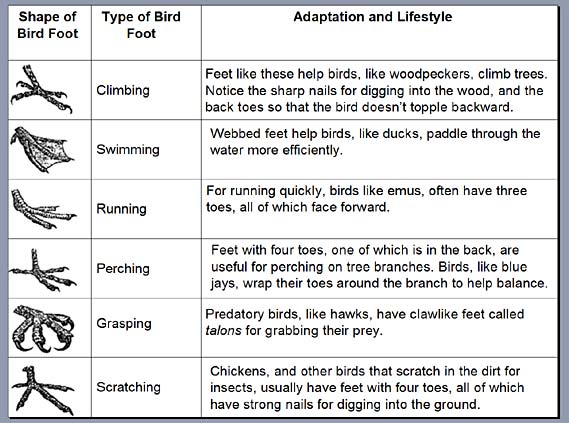
|
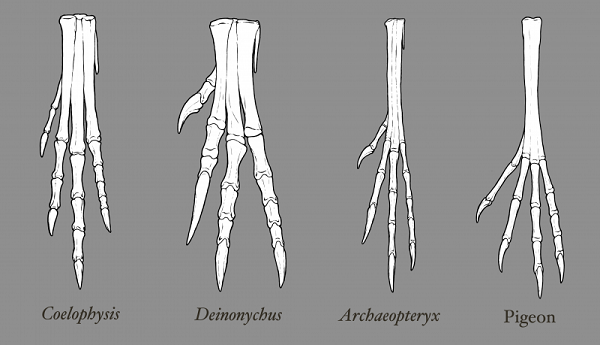 |
Two interesting points as an animal becomes more "birdlike": the hallux moves towards greater mobility, and the tarsometatarsus fuses. The tarsometatarsus of Archaeopteryx represents a unique semi-fused "transition" state between unfused and totally fused metatarsal bones. Emily Willoughby, Paleo-art and bird illustration |
The bones of the hand can be divided into three categories:
8 + 5 = 13... (3 X 4 + 2) = 14... 13 + 14 = 27 X 2 hands = 54 bones (like 54 in a deck of cards with the 2 jokers included) 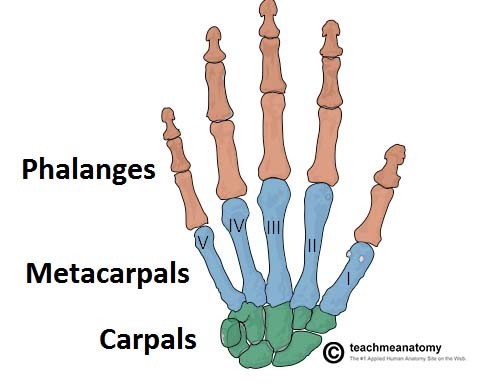 Teach Me Anatomy: Human hand bones |
The bones of the foot can be divided into three categories:
(7 + 5) = 12... + (3 X 4 + 2) = 14... 12 + 14 = 26 X 2 feet = 52 bones (like 52 in a deck of cards without the jokers), which provide us with 13 "ranks" (Ace, King, Queen, Jack, 2...10 of four cards each consisting of clubs, diamonds, spades and hearts)  Teach Me Anatomy: Human Foot bones |
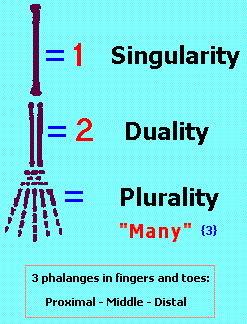
If we proceed from the multiple or "many" bones in the foot and hand towards the linked arm and leg appendages, it is a (philosophically) curious thing to note that the "many" is followed (or preceded) by two bones and these are followed (or preceded) by one bone. Hence, we have a "One- Two- Many" configuration that many a student studying anatomy may not take into (philosophical) consideration when increasing their knowledge with comparative anatomy. No less, when taking comparative anatomy into consideration, there may not be an interest for some to include other species like birds... because when the quantity of toes is counted, the difference can be dismissed by referring to the birds as "just birds"... and therefore have less value when an anatomical over-view is considered. Yet, philosophically, all life forms should be taken into account since they are part of the overall biosphere.
While the three divisions of the foot and hand might be viewed as arbitrary ones since other formulas might be used, we nonetheless find yet another "arbitrary" use of the "three". In other words, we do not find the same "arbitrary" usage of some other pattern. If an anthropologist were to claim that other cultures make use of other patterns such as two, four, five, etc., the word "culture" in the context of the Earth's environment must likewise be noted. In other words, it is the environment which is influencing such predispositions and the Earth's environment is deteriorating. The deteriorations may well account for what many describe as the "evolutionary" development of a species due to adaptations, accommodations, and rationalizations as a means of making adjustments to the deteriorations.
The three deteriorations which are taking place and humanity is not smart enough to deal effectively with, are:
- The moon is moving away (receding) from the Earth which results in a depletion of tidal ("washing machine") behavior.
- The rotation of the Earth is slowing causing a change in the electro-dynamo effect of the core/mantle/crust interactions.
- The Sun's energy is depleting and it is thought that along the course of its demise it will enlarge to the point of consuming the innermost three planets (Mercury, Venus, Earth). As seen from Earth, the enlargement will produce a "fusion" of the life-affecting three solar "moments" called dawn, noon, and dusk.
Because biology is fixed in the present environment, it is subjected to the incremental deteriorations and must make adaptations to the body/mind/spirit triad as a coping mechanism. Our business, political and religious belief systems make rationalized adjustments to environmental changes such as the change in seasons. If all of us were subjected to one or another weather pattern that incrementally increases and we could detect the changes, our lives would be accommodated accordingly. But even if you are not aware of incremental changes, you nonetheless make changes or are left adaptively unprepared and will suffer the consequences. Biology is a reflection, are different symbols of environmental influences... but most people appear to be unable to decipher what the symbols are or what they mean. Humanity is heading towards extinction in response to a deteriorating environment, because it persists in holding on to antiquated notions practiced by religion and nature ideas involving ludicrous notions such as "fatherland", "motherland" and "mother earth"... and will not sever the umbilical cord in order to sustain a longer viability away from the decaying planetary system.
Page initially created: Monday, 29-May-2017... 7:20:05 AM
Initial Posting: Monday, 17-July-2017... 5:01 AM
Updated Posting: Sunday, 13th-May-2018... 6:34 AM
Most Recent update: Monday, 13th, March 2023... 10:30 AM
Herb O. Buckland
herbobuckland@hotmail.com